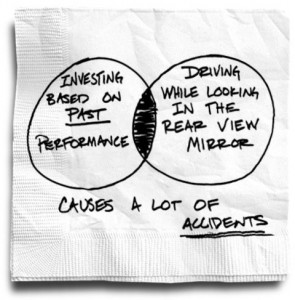The Temptation (and Danger) of Past Investment Performance – NYTimes Bucks Blog
 It’s understandable. We look to invest in something different in our 401(k), and what is the most accessible bogey to judge the funds in your plan? Past performance. They tug at the foundation of human nature, greed and fear. Our friend Carl Richards wrote an excellent piece in the NYTimes.com Bucks Blog on this topic:
It’s understandable. We look to invest in something different in our 401(k), and what is the most accessible bogey to judge the funds in your plan? Past performance. They tug at the foundation of human nature, greed and fear. Our friend Carl Richards wrote an excellent piece in the NYTimes.com Bucks Blog on this topic:
Whenever a mutual fund advertises performance, the Securities and Exchange Commission requires that it includes the disclaimer that “past performance does not guarantee future results.”
A new study by researchers at Arizona State University and Wake Forest Law School suggests that this warning is not enough. They recommend something a bit stronger: “Do not expect the fund’s quoted past performance to continue in the future. Studies show that mutual funds that have outperformed their peers in the past generally do not outperform them in the future. Strong past performance is often a matter of chance.”
Despite the warning from the S.E.C. and pretty conclusive evidence that past performance has very little predictive value, most of us still use performance as the predominant factor in choosing our investments.
This is one of those times in investing where our experience in almost every other area of life works against. If you’re going to hire contractors to remodel your house, one of the first things you do is look at other houses they have done. It seems reasonable to expect that the work they do on your house will be at least as good, if not better.
When it comes to mutual funds, however, the past has almost no predictive value. People have spent years looking for a way to identify mutual funds that will do well going forward. They have looked at almost every factor you can think of: education, experience, hair color and, of course, past performance.
The only factor anyone has found with any predictive value was the internal costs of the fund. The higher the costs, the worse the performance. This is a case where you often get what you do not pay for.
Despite all the evidence to the contrary, we still scour the annual lists of “Ten Hot Funds to Own Now,” which are often based on past performance, looking for a place to put our life savings. We still look in the rear-view mirror. Think about the last time you made an investment decision. Did you look to the past for some prediction of the future? After all, how much sense would it make to invest in a fund that had performed poorly?
But finding the next Peter Lynch is an almost impossible task. Focus instead on finding a low-cost investment that you can stick with over the long haul.
